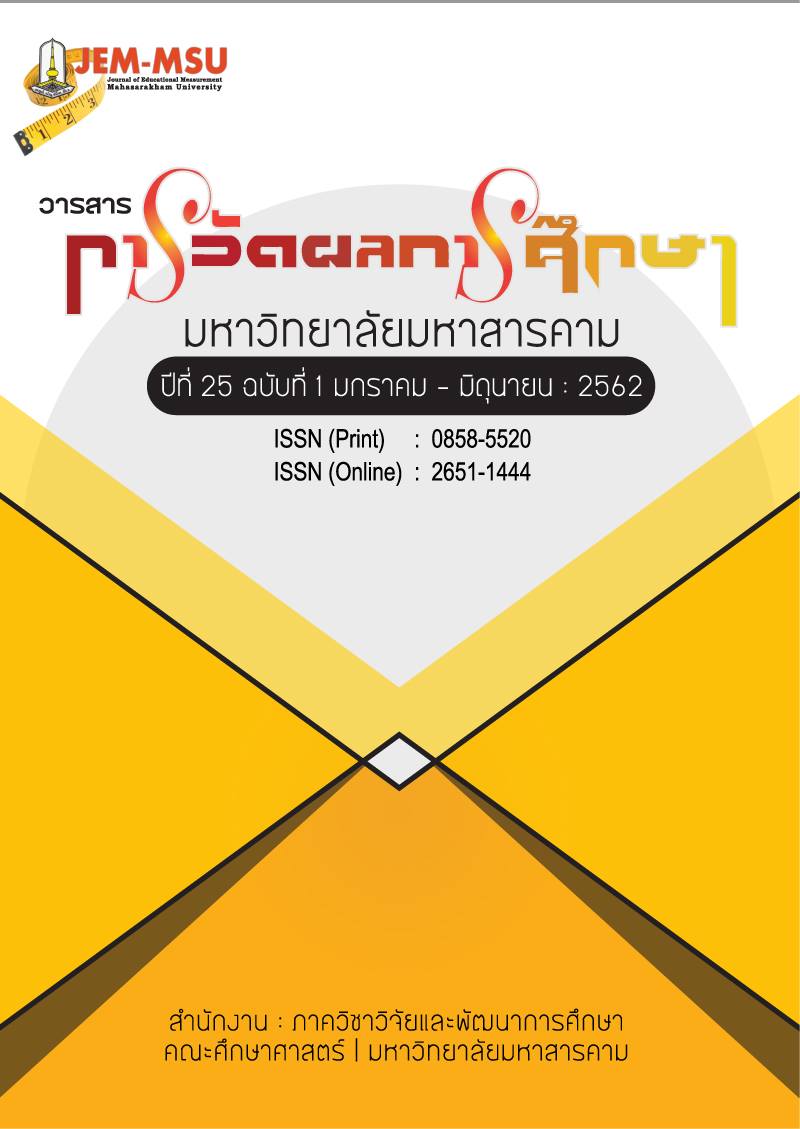Characteristics of Rajabhat University Students on the New Frontier of Learning toward Education 4.0
Main Article Content
Abstract
This study aimed to develop indicators of characteristics of graduates in Education 4.0 of Rajabhat university students, to study the characteristics of graduates in Education 4.0 of Rajabhat university students, and to analyze the latent group profile (LPA) of the characteristics of graduates in Education 4.0 of Rajabhat university students. The sample comprised 9 experts on education and 2,148 students, obtained through multi-stage sampling. The findings are as follows:
1) The characteristics of the graduates in the Education 4.0 of Rajabhat university students comprised 3 components with 24 indicators. Component 1: Social Responsibility, comprising 9 indicators; Component 2: Creative Productivity, comprising 7 indicators; and Component 3: Skills of Graduates 4.0, comprising 8 indicators.
2) As a whole, Rajabhat university students had the characteristics of graduates at a high level in every component. The characteristic of graduates with the highest mean was Component 1: Social Responsibility, having the mean of 4.11. The second highest was Component 3: Skills of Graduates 4.0, having the mean of 3.92; and Component 2: Creative Productivity came last, with the mean of 3.76, respectively.
3) In the LPA of the characteristics of graduates in the Education 4.0 of Rajabhat university students, 3 models were obtained. The number of groups in each model was 2, 3 and 4, respectively. When considering the probability that the classification was the most accurate (Ek), the model with 3 groups (likelihood = -3883.156, AIC = 7794.312, BIC = 7873.718, ABIC = 7829.238, Ek = 0.816) was the most suitable. Group 1 had an average lower than the probability of 243. The average group was closer to the probability of 1167, and the third group had the average lower than the probability of 737.
Article Details
The content and information contained in the published article in the Journal of Educational Measurement Mahasarakham University represent the opinions and responsibilities of the authors directly. The editorial board of the journal is not necessarily in agreement with or responsible for any of the content.
The articles, data, content, images, etc. that have been published in the Journal of Educational Measurement Mahasarakham University are copyrighted by the journal. If any individual or organization wishes to reproduce or perform any actions involving the entirety or any part of the content, they must obtain written permission from the Journal of Educational Measurement Mahasarakham University.
References
กฤตยา ฐานุวรภัทร์. (2555). คุณลักษณะบัณฑิตที่พึงประสงค์สำหรับสถานประกอบการกรณีศึกษาบัณฑิตสาขาวิชาภาษาอังกฤษเพื่อการสื่อสาร คณะสังคมศาสตร์และศิลปศาสตร์ มหาวิทยาลัย
นอร์ท-เชียงใหม่. มหาวิทยาลัยนอร์ท-เชียงใหม่.
กัลยา ติงศภัทิย์. (2557). “เส้นทางสู่ศตวรรษที่ 2”การสัมมนาทางวิชาการ เรื่อง ขอบแดนใหม่แห่งการเรียนรู้:การศึกษาระบบ 4.0 (New Frontier of Learning : Education 4.0). ศูนย์นวัตกรรมการเรียนรู้จุฬาลงกรณ์มหาวิทยาลัย
กัลยา อัมพปฏิภาค. (2547). การส่งเสริมให้นักเรียนคิดอย่างสร้างสรรค์. การศึกษาวิทยาศาสตร์ คณิตศาสตร์และเทคโนโลยี, 33 (132).
ไกรยส ภัทราวาท. (2559). เดินหน้าการศึกษาไทยอย่างไรให้ตอบโจทย์ Thailand Economy 4.0” [ออนไลน์]. ได้จาก http://www.manager.co.th/ QOL/ViewNews.aspx?NewsID =9590000069668 [สืบค้นเมื่อวันที่ 20 กันยายน 2559].
ตะวัน เทวอักษร. (2555). พัฒนาสื่อการเรียนการสอน เตรียมเด็กไทยสู่ศตวรรษที่ 21. School in focus, 4 (11), 19.
บรรพต พรประเสริฐ. (2538). การศึกษาเปรียบเทียบความคิดสร้างสรรค์ของเด็กปฐมวัยที่มีระดับทักษะพื้นฐานการสังเกตแตกต่างกันที่ได้รับการสอนโดยใช้กิจกรรมสร้างสรรค์ทางรูปภาพ กิจกรรมสร้างสรรค์ทางสัญลักษณ์ กิจกรรมสร้างสรรค์ทางภาษาตามแบปกติ. วารสารการวิจัยทางการศึกษา, 25(2-4)
บุญเลิศ อรุณพิบูลย์. (2557). LearnSquare : LMS สายพันธุ์ไทยโดยเนคเทค.[ออนไลน์]. ได้จาก http://www.thailibrary.in.th/2013/09/06/xampp/ สืบค้นเมื่อวันที่ 25 กุมภาพันธ์ 2561
พิสชา บัวครื้น. (2559). การพัฒนาเกณฑ์และตัวบ่งชี้คุณลักษณะบัณฑิตที่พึงประสงค์เพื่อประเมินนักศึกษาระดับปริญญาตรีของมหาวิทยาลัยในกำกับของรัฐ. สำนักพัฒนาเทคนิคศึกษา มหาวิทยาลัยเทคโนโลยีพระจอมเกล้าพระนครเหนือ . [ออนไลน์]. ได้มาจาก http://ojs.kmutnb.ac.th/index.php/joited/article/view/498 [สืบค้นเมื่อวันที 22 กันยายน 2559].
ไพฑูรย์ สินลารัตน์. (2558). ปรัชญาการศึกษาเชิงสร้างสรรค์และผลิตภาพ. กรุงเทพฯ : โรงพิมพ์แห่งจุฬาลงกรณ์มหาวิทยาลัย.
__________.(2559). การศึกษา 4.0 เป็นยิ่งกว่าการศึกษา. กรุงเทพฯ : โรงพิมพ์แห่งจุฬาลงกรณ์มหาวิทยาลัย. มหาวิทยาลัยสุโขทัยธรรมาธิราช. (2555). ประกาศมหาวิทยาลัยสุโขทัยธรรมาธิราชเรื่องคุณลักษณะบัณฑิตที่พึงประสงค์ ระดับปริญญาตรี ปริญญา โท ปริญญาเอก. มหาวิทยาลัยสุโขทัยธรรมาธิราช.
ลม เปลี่ยนทิศ. (2559). “คนไทย 4.0 สังคม 4.0 การศึกษา ?.0.” สำนักข่าวเจ้าพระยา. [ออนไลน์]. ได้จาก
http://chaoprayanews.com/blog/article/2016/08/04 [สืบค้นเมื่อวันที่ 15 กันยายน].
วัชรินทร์ แพงศรี และธีระ ฤทธิรอด. (2557). คุณลักษณะของบัณฑิตที่พึงประสงค์ตามกรอบมาตรฐานคุณวุฒิระดับอุดมศึกษาแห่งชาติ (TQF: HEd) ของนักศึกษาระดับบัณฑิตศึกษามหาวิทยาลัยขอนแก่น. สาขาวิชาบริหารธุรกิจวิทยาลัย บัณฑิตศึกษาการจัดการ มหาวิทยาลัยขอนแก่น.
วิจารณ์ พานิช. (2555). การบรรยายหัวข้อเรื่อง “การผลิตบัณฑิตในศตวรรษที่ 21” ณ ห้องสุรนารี สุรสัมมนาคาร มหาวิทยาลัยเทคโนโลยีสุรนารี. วันที่ 11 กันยายน 2555.
ศศิกาญจน์ สกุลปัญญวัฒน์ และอิมรอน มะลูลีม. (2557). การพัฒนารูปแบบการจัดสภาพแวดล้อมการศึกษา เพื่อผลิตบัณฑิตที่มีคุณลักษณะที่พึงประสงค์ตามกรอบมาตรฐานคุณวุฒิระดับอุดมศึกษาแห่งชาติ สาขาพยาบาลศาสตร์ (TQF) พ.ศ.2552. วารสารวิชาการมหาวิทยาลัยอีสเทิร์นเอเชีย, 4(1), มกราคม-เมษายน.
ศิริพงษ์ เพียศิริ. (2551). บัณฑิตสร้างสรรค์ : บัณฑิตสร้างชาติ (Creative Graduate : Creative Nation).วารสารศึกษาศาสตร์ ฉบับวิจัยบัณฑิตศึกษา, 31(4), กรกฎาคม – กันยายน 2551.
สมเกียรติ อ่อนวิมล. (2556). (2556, 18 ธันวาคม). คุณสมบัติผู้เรียนแห่งศตวรรษที่ 21. เดลินิวส์.
สํานักงานคณะกรรมการพัฒนาการเศรษฐกิจและสังคมแห่งชาติ. (2544). แผนพัฒนาเศรษฐกิจและสังคมแห่งชาติฉบับ ที่ 9 พ.ศ. 2545 - 2549. สํานักงานคณะกรรมการพัฒนาการเศรษฐกิจและสังคมแห่งชาติ.
สำนักงานคณะกรรมการการศึกษาแห่งชาติ. (2544). แนวทางการปฏิรูปการศึกษาระดับอุดมศึกษาตามพระราชบัญญัติการศึกษาแห่งชาติ พ.ศ. 2542. รายงานชุด แนวทางการปฏิรูปอุดมศึกษาไทย. กรุงเทพมหานคร: คณะกรรมการจัดทำแนวทางการปฏิรูปอุดมศึกษา สำนักงานคณะกรรมการการศึกษาแห่งชาติ.
สุนันท์ สีพาย. (2560). การศึกษาคุณลักษณะของครูที่ดีในศตวรรษที่ 21. (ได้รับทุนสนับสนุนจากสำนักงานคณะกรรมการวิจัยแห่งชาติ ประจำปี 2560). มหาวิทยาลัยราชภัฏชัยภูมิ.
สุพจน์ หารหนองบัว.(2559). ชูจัดการศึกษาระบบ 4.0. [ออนไลน์]. ได้มาจาก http://daily.khaosod.co.th/
view_news.php?newsid=TURObFpIVXdNakkyTURnMU9BPT0=§ionid=TURNeE5RPT0=&day=TWpBeE5TMHdPQzB5Tmc9PQ== [สืบค้นเมื่อวันที่ 15 กันยายน 2559].
อุดม คชินทร. (2561). ทิศทางการพัฒนา นศ. เพื่อสนับสนุนการเดินหน้าประเทศไทย.[ออนไลน์] .ได้มาจาก http://www.moe.go.th/moe/th/news/detail.php?NewsID=50496&Key=newsTeerakiat [สืบค้นเมื่อ วันที่ 7 เมษายน 2561].
Fan, X., & Wang, L. (1998). Effects of potential confounding factors on fit indices and parameter esti Mates for true and misspecified SEM models. Educational and Psychological Measurement, 58,699–733.
Hair, J. F., Anderson, R. E., Tatharm, R. L., and Black, W. C. (1998). Multivariate Data Analysis. NJ: Prentice-Hall.
Juke, I. & Dosaj, A. (2006). Understanding digital children (DKs) : Teching & learning in the new digital landscape. Retrieved April 8, 2014 from http://edorigami.wikispaces.com/Understanding+Digital+Children+-+Ian+Jukes.
Webel, H. (1996). Using latent class analysis to detect behavioral pattern in systems of observational variables. Evaluation and Program Planning, 19 Vols. Great Britain.


